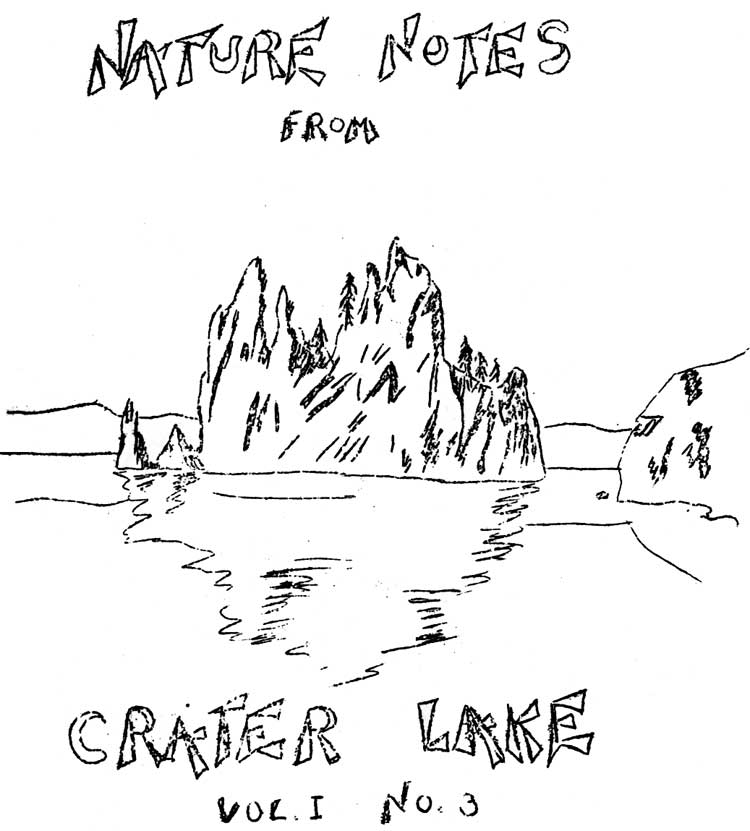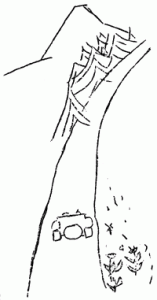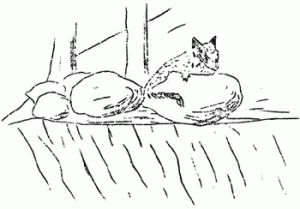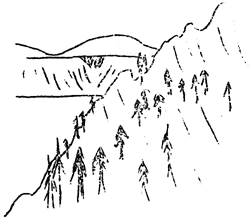
Volume I No. 3 – September 1, 1928All material courtesy of the National Park Service.These publications can also be found at http://npshistory.com/Nature Notes is produced by the National Park Service. © 1928. |
Good Roads — Better Flowers
By Earl U. Homuth
The improvement of roads in Crater Lake National park, which will probably be completed this year, will be of benefit in other ways than those generally associated with good highways.
Not only will the clouds of fine volcanic dust, stirred up by passing machines no longer be a menace and a discomfort, when surfacing and oiling is finished, but improvement in the condition of the plant life beside these roads will follow. This is already very noticeable where work has finished in previous years. The continuous showers of fine, powdery dust were stunting and killing the vegetation, and the contrast between the areas beside the completed oiled roads and those not yet finished is very marked.
Next season with all the work on approach roads done, we may expect all approaches to Crater Lake to be bordered with flowers and other plant life which has returned to its normal luxuriant condition.
A Rare Fern From Crater Lake
Crater Lake seems to be an especially favorable locality for the bizarre and unusual plant life. Besides the seven new species that Colville found in this region in 1896, he has since described another. (In Underw. Nat. Ferns ed. 669, 1900). This is a little fern that grows only on the highest pumice slopes. It really is not a true fern since the fronds are not circinate in the bud, the sporangia do not have typical fern’s annulus, and the spores are formed within the tissue of the sporophyll. By these characteristics we place it in the Adder’s Tongue Family (Opheoglossaceae) but still for all practical purposes we may call it a fern.
Its extreme rarity is evidenced by the fact that it has been found by collectors only twice. The type specimen was found a good many years ago, but since then it has “hidden out” on us completely, with the single exception of a specimen which was collected this season.
Not only its rarity, but also its protective coloration aids it in escaping notice. The leaves, or fronds, are a dull grey color, which blends perfectly with the pumice slopes on which it grows. This is a fortunate circumstance, since it would soon become extinct were it at all conspicuous.
Botanists call this plant Botrychium pumicola, which altho grammatically incorrect as Latin names go, means “pumice inhabitant.”
Ouch!
While relaxing peacefully with a bit of light literature under a tall hemlock on a sunny slope, the writer was disturbed by the sharp sensations such as an ant may impart. After the experience had been repeated several times a casual search for the insects was begun, and there were none. But the ground was found to be littered with several dozen porcupine quills. A good collection was gathered as mementoes of an experience which had previously been duplicated only with cactus, in the deserts of the Southwest.
Porcupines are often noticed in the Park. Near the Community House several fir trees show dead branches, and bark peeled off about thirty feet above the ground, evidently the work of these rodents. A ranger reports avoiding possible punctures while driving on the Rim Road late one evening, by giving a porcupine ample time to decide to amble into the woods instead of following down the roadway as it did for several yards.
Look Out Below!
By Earl U. Homuth
Something in the nature of the spectacular is often afforded visitors to the Lake, when enjoying the boat trips. The cliff above being almost perpendicular, a small rock becoming dislodged may create a considerable rock-slide. The roar of this descending material can frequently be heard for a great distance. The huge boulders dashing into the water, and the clouds of dust which trace their path offer a sight worth seeing.
A nature party on the rim was recently observing the antics of two chipmunks which were skirmishing around among the rocks and along the slope of loose gravel and sand above the topmost layer of lava. One of these chipmunks presently dislodged a small pebble, and in rolling this loosened others; soon a very respectable slide was cascading over the lava cliff onto the slope below, gathering more material there and continuing on downward toward the lake.
The slide was hardly of proportions to attract attention, but had it been observed, any guesses as to origin would hardly have included a chipmunk among the possibilities.
* * * * * * * * * * * * * * * * * * * *
The first family of camp-robbers are reported by Ranger Robert Beck, from the West Entrance. They are already sociable and make the checking station their headquarters.
Crater Lake
By Earl U. Homuth
In previous issues of these notes evidence and theories as to the formation of the caldera in which Crater Lake lies were discussed. A few facts concerning the lake itself may be of interest.
Since the Rim of Crater Lake is the base of the original Mt. Mazama, drainage from the lake and into the lake is represented throughout its entire circumference by the very edge of these cliffs alone. The walls are exceedingly sheer. At no point is there a stream of even small size flowing over the edge, into the caldera. The water in the lake therefore is the rain and snow which falls upon it directly or upon the very narrow area of the cliffs. Hence it may be considered as not only very pure water, but actually distilled water. Any mineral content would be negligible because of the small drainage area, and because of the character of the rock composing the walls. Many springs, some of considerable size, issue from the walls, and would add to the mineral content, but this also would be proportionately insignificant considering the quantity of water present, since the lake is nearly two thousand feet deep, with an area of over twenty square miles.
The lake has never been known to freeze, altho others in the vicinity and at lower altitudes are covered with ice each winter. The normal water temperature during the summer varies between 38 ° F. and 41°F. altho surface temperatures are of course higher.
The water level changes about four feet throughout the year, being highest during maximum melting of snow, after the winter season and lowest in September or early October. Precipitation is estimated to average over 60 inches per year. Great amounts of snow are blown over the edge of the rim. Then too, the numerous springs add to the accretion. Evaporation is estimated to be about forty inched per year. Calculations on the rate of lowering and rate of evaporation indicate a more rapid lowering than could be accounted for by this agency alone. Since there is no surface outlet the surplus probably escapes through the porous rocks of the walls reappearing as springs which are numerous on the southeast base of Mt. Mazama.
Other pages in this section






